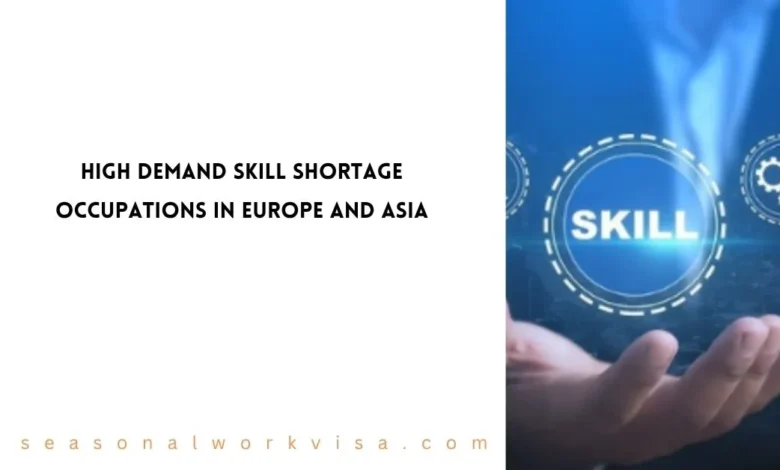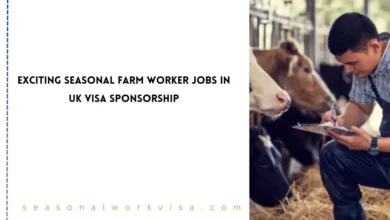High Demand Skill Shortage Occupations in Europe and Asia

In the dynamic employment market of today, demand for particular occupations fluctuates quickly, frequently on a monthly basis. Globally, governments are continuously modifying their work visa regulations in response to emerging trends, including aging populations, sustainability objectives, and technology advancements. Global mobility is strongly impacted by these changes, which phase out certain occupations while creating opportunities for others.
20 in-demand jobs in Europe, the West, and Asia that are eligible for skill shortage visa programs are included in this article, which is your go-to resource for 2025. This guide will show you where your skills are needed, what migration routes are available, and how to match your qualifications with nations that are actively hiring if you’re a skilled worker hoping to pursue a career overseas.
10 Occupations That Faded in 2025 Due to AI and Industry Changes
Here are ten (10) occupations that experienced a precipitous decline in demand as a result of automation, digitization, or artificial intelligence (AI) advancements to help you avoid investing in dwindling job markets as of June 2025:
1. Data Entry Clerks
- The reason for the decline is that automated data processing tools like AI-powered optical character recognition (OCR) are now able to extract and input data more quickly and precisely than people.
- Alternative Careers: Support positions for digital transformation, data administration, or data analysis.
2. Telemarketers
- Why Refused: AI-driven chatbots, voice assistants, and customized marketing technologies provide highly efficient and customized client service around-the-clock.
- Other Career Paths: AI chatbot training, social media strategy, and digital marketing.
3. Retail Cashiers
- Why Refused: The necessity for human cashiers has been greatly diminished by self-checkout kiosks, contactless payments, and completely automated businesses.
- Other career options include warehouse operations, customer experience positions, and retail tech management.
4. Travel Agents
- Why Refused: Without a human middleman, customers may easily plan and book travel with DIY booking services like Google Travel, Expedia, and AI itinerary generators.
- Alternative Careers: Designing remote experiences, curating tours, or producing travel-related content.
5. Bank Tellers
- Why Refused: The popularity of digital wallets, virtual financial advisors, and online and mobile banking has reduced the need for in-person teller visits.
- Alternative Careers: Compliance analysis, UX positions in digital banking, or FinTech client service.
6. Proofreaders
- Reasons for Declining: Complex grammar and style checks may now be handled instantaneously by sophisticated AI language models seen in editing programs like Grammarly, ChatGPT, and others.
- Other career options include positions in content planning, SEO authoring, AI editing, and review.
7. Receptionists
- Why Refused: Conventional front desk positions in hotels and companies are being replaced by AI scheduling tools, virtual receptionists, and automated visitor management systems.
- Other career options include community manager, virtual assistant, and guest experience coordinator.
8. Simple Assembly Line Workers
- Why Refused: In industries, repetitive, manual operations have been replaced by industrial robots and machine learning-based manufacturing systems.
- Other Career Options: Automation programming, QA technician, or robotics maintenance.
9. Paralegals (Basic Tasks)
- Why Refused: The necessity for junior paralegals has decreased as a result of legal AI tools’ ability to research case law, create legal drafts, and summarize documents.
- Alternative Jobs: AI legal trainer, compliance assistant, or legal tech assistance.
10. Stock Clerks
- Why Refused: The need for human stock clerks has been greatly reduced by automated warehouse robotics, real-time inventory systems, and drone scanning.
- Other career options include supply chain management, logistics planning, and warehouse robotics.
High-Demand Occupations in 2025 by Country and Category
You can see clearly what each country is seeking for in 2025 by glancing at the accompanying table, which breaks down specific skill shortages by area and occupation. Here are the hiring companies and locations for engineers, medical heroes, and logistics specialists:
| Country/Region | Healthcare | IT & Digital | Engineering & Trades | Education & Social Care | Logistics & Others |
|---|---|---|---|---|---|
| USA | Nurses, Doctors | AI/ML, Cybersecurity, Developers | Civil/Mechanical Engineers, Welders | K-12 Teachers, Professors | Truck Drivers, Restaurant Staff |
| Canada | Pharmacists, GPs | Data Analysts, IT Ops, Cloud | Electricians, Carpenters | Early Childhood Educators | Machine Operators |
| Germany | Nurses, Physiotherapists | Software Engineers, AI Experts | Industrial Engineers, Plumbers | STEM Teachers | Warehouse Operators |
| France | Caregivers, Medical Techs | Network Admins, Cyber Analysts | Renewable Energy Engineers, Roofers | Social Workers | Construction Labourers |
| Australia | Midwives, Radiographers | ERP Experts, Developers | Civil Engineers, Electricians | Teachers | Welders, Truck Drivers |
| New Zealand | Occupational Therapists | ICT Admins, Software Devs | Aircraft Engineers, HVAC Technicians | Professors, School Teachers | Packaging Workers |
| Singapore | Clinical Psychologists | Blockchain Devs, AI Scientists | Semiconductor Engineers, R&D Leads | Social Workers | Marine Superintendents |
| Japan | Surgeons, Nurses | Software Engineers, Translators | Robotics & Electrical Engineers | Bilingual Teachers | N/A |
| South Korea | Geriatric Specialists | Quantum Computing Experts | Display Tech Engineers, IC Designers | Special Needs Educators | N/A |
| China | Biotech Experts, Doctors | AI Engineers, Fintech Devs | Chemical Engineers, Green Tech Devs | Curriculum Developers | Business Development Managers |
Demand Regions and Work Visa Pathways for Skilled Workers (2025)
You must ascertain which work visa programs correspond with your line of work before you pack your bags. The primary work visa categories in important destination nations are included in the following table along with the kinds of positions they hope to fill in 2025:
| Demand Region/Country | Key Visa/Immigration Pathways | Brief Purpose/Eligibility |
| USA | H-1B Visa, O-1 Visa, EB-2 Green Card | Specialty occupations, extraordinary ability, advanced degrees in shortage fields |
| Canada | Express Entry (Category-based draws) | Permanent immigration for skilled workers in healthcare, trades, education |
| EU (General) | EU Blue Card, ICT Permit, European Talent Pool & Talent Partnerships | Highly skilled professionals, intra-company transfers, fast-track for shortage roles |
| France | Talent Passport, Salarié Visa | Highly skilled in shortage fields, permanent or temporary employment contracts |
| Germany | EU Blue Card, Skilled Immigration Act, Job Seeker Visa | Qualified non-EU professionals, job seekers, faster recognition of credentials |
| UK | Skilled Worker Visa | General skilled workers with sponsor, salary thresholds and language requirements |
| Sweden | Sweden Work Permit, EU Blue Card, Job Seeker Visa | Job offers in listed shortage occupations, highly skilled migrant options |
| Australia | Skilled Independent, Nominated, Regional Visas | Points-tested skilled migration, sponsored by state/territory, or regional employers |
| New Zealand | Green List: Straight to Residence, Work to Residence | Critical shortage roles, fast-track permanent residency options |
| China | Work Permit (Category A, B) | Category A: high-level talent; Category B: skilled professionals with experience |
| Japan | Highly Skilled Professional Visa | Points-based for professionals in IT, engineering, healthcare, teaching |
| South Korea | Top-Tier Visa Program, E-7 Visa | Advanced tech sector, skilled professionals with job offers and income criteria |
Consolidated Table: Top 20 Skill Shortage Occupations Globally (2025)
Finally, a global compilation of the top 20 most sought-after professions based on common demands in Europe, the West, and Asia. Additionally, this table displays which regions are hiring for each position as well as the possible visa pathways to apply for them:
| Rank | Occupation | Primary Skill Area | Regions with Demand | Relevant Visa Program Examples |
| 1 | Software Developers / Engineers | Information Technology | Europe, West, Asia | EU Blue Card, US H-1B, Canada Express Entry, AU SOL, NZ Green List, SK E-7 |
| 2 | Nurses / Healthcare Professionals | Healthcare & Social Services | Europe, West, Asia | EU Blue Card, US J-1/EB-2, Canada EE, AU SOL, NZ Green List, Japan HSP |
| 3 | AI & Machine Learning Specialists | Information Technology | Europe, West, Asia | EU Blue Card, US H-1B, AU SOL, NZ Green List, SK E-7, China Cat A |
| 4 | Civil Engineers | Engineering & Construction | Europe, West, Asia | EU Blue Card, US H-1B, Canada EE, AU SOL, NZ Green List |
| 5 | Cybersecurity Specialists | Information Technology | Europe, West, Asia | EU Blue Card, US H-1B, AU SOL, NZ Green List, SK E-7 |
| 6 | Data Scientists / Analysts | Information Technology | Europe, West, Asia | EU Blue Card, US H-1B, AU SOL, SK E-7, China WP |
| 7 | Electricians / Skilled Tradespeople | Construction & Trades | Europe, West | EU National Permits, US H-2B/EB-3, Canada EE |
| 8 | Mechanical Engineers | Engineering & Manufacturing | Europe, West, Asia | EU Blue Card, US H-1B, AU SOL, Japan HSP, SK E-7 |
| 9 | Doctors / Surgeons | Healthcare & Life Sciences | Europe, West, Asia | EU Blue Card, US J-1/EB-2, Canada EE, AU SOL, Japan HSP |
| 10 | Cloud Computing Experts / Architects | Information Technology | Europe, West, Asia | EU Blue Card, US H-1B, AU SOL, SK E-7, China WP |
| 11 | Renewable Energy Engineers | Green Economy & Engineering | Europe, West, Asia | EU Blue Card, US H-1B, AU SOL, China WP |
| 12 | Teachers / Educators | Education | Europe, West, Asia | National Permits, US H-1B/J-1, Canada EE, AU SOL |
| 13 | Welders / Metal Workers | Manufacturing & Trades | Europe, West | EU National Permits, US H-2B, Canada EE |
| 14 | Logistics & Transport Workers | Transportation & Logistics | Europe, West | EU National Permits, US H-2B |
| 15 | General R&D / Production Engineers | Engineering & Manufacturing | Europe, Asia | EU Blue Card, Japan HSP, SK E-7, China WP |
| 16 | Financial Professionals | Finance & Business Services | Europe, West, Asia | EU Blue Card, US H-1B, Singapore WP |
| 17 | Social Workers / Care Professionals | Social Services | Europe, West, Asia | EU National Permits, Canada EE, Singapore WP |
| 18 | Construction Workers / Labourers | Construction | Europe, West | EU National Permits, US H-2B |
| 19 | Manufacturing & Machine Operators | Manufacturing & Industry | Europe, West | EU National Permits, US H-2B |
| 20 | Hospitality & Service Workers | Hospitality & Tourism | Europe, West | EU National Permits, US H-2B/J-1 |
The purpose of this guidance is to enable qualified professionals to boldly seek opportunities abroad. Building a worldwide career in 2025 and beyond begins with knowing where the demand is and which visas open the door, regardless of your industry—tech, healthcare, engineering, education, or trades.
References
- Cedefop. (n.d.). Communication: Union of skills. Retrieved from https://www.cedefop.europa.eu/files/communication_-_union_of_skills.pdf
- Jobs and Skills Australia. (2025, February). International Labour Market Update – February 2025. Retrieved from https://www.jobsandskills.gov.au/download/19744/international-labour-market-update-february-2025/3081/international-labour-market-update-february-2025/pdf
- World Bank. (2022, July 18). Labour Market Trends and the Future of Work in Emerging Markets. Retrieved from https://documents1.worldbank.org/curated/en/099550107182219118/pdf/IDU00f035be3001db04ff609eef0970f48bd2900.pdf
- International Labour Organization (ILO). (2025). Global employment forecast downgraded: 7 million jobs lost by 2025 amid rising risks. Retrieved from https://www.ilo.org/resource/news/global-employment-forecast-downgraded-7-million-jobs-2025-amid-rising
- Organization for Economic Co-operation and Development (OECD). (2025). OECD International Forum on Migration Statistics 2025. Retrieved from https://www.oecd-events.org/ifms2025
- Immigration, Refugees and Citizenship Canada (IRCC). (2025, February). Canada announces 2025 Express Entry category-based draws and plans for more in-Canada draws to reduce labour shortages. Retrieved from https://www.canada.ca/en/immigration-refugees-citizenship/news/2025/02/canada-announces-2025-express-entry-category-based-draws-plans-for-more-in-canada-draws-to-reduce-labour-shortages.html
- UNESCO. (2023). World Teachers’ Day: UNESCO sounds alarm on global teacher shortage crisis. Retrieved from https://www.unesco.org/en/articles/world-teachers-day-unesco-sounds-alarm-global-teacher-shortage-crisis
Conclusion:
Knowing where your abilities are in demand in the ever-changing work market may be the key to opening up international career options. Skilled workers in IT, healthcare, engineering, education, and trades are in a good position to transfer overseas as nations actively improve their immigration laws to draw in specialized expertise. Investing in dwindling industries can be avoided by being aware of the roles that are being replaced by automation and artificial intelligence. Success in today’s globalized workforce depends on matching your experience with worldwide shortages and comprehending pertinent visa procedures, whether you’re looking to relocate or improve your career.
Frequently Asked Questions
What are skill shortage visa programs?
These are immigration routes that nations provide to draw in foreign workers for jobs where there is a local skill shortage. The EU Blue Card, Canada Express Entry, and Australia’s Skilled Independent Visa are a few examples.
What jobs are declining due to AI and automation?
As AI technologies and automation replace repetitive and predictable work, jobs like bank tellers, retail cashiers, telemarketers, data entry clerks, and travel agents are becoming less common.




